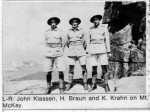Page 1 | Page
2 | Page 3 | Page
4
The
most popular poem from the First World War is John McCrae's “In
Flanders Fields.” The first two lines are “In Flanders
fields the poppies blow / Between the crosses, row on row.” This
poem is a major reason why, today, the poppy is worn on November
11 as a symbol of remembrance.
Do
you know what McCrae was doing when he wrote the poem? He wrote
it in 1915 while treating the wounded in Ypres, France. He was a
surgeon in the medical corps of the Canadian army.
Many
Canadian COs also wanted to serve in the medical or dental corps.
In this way, they hoped to be able to relieve the suffering of war
instead of participating in it. Not all COs thought that this was
an appropriate option; some thought that COs should not be under
military control, even if it was as a non-combatant. Mennonites
in Russia had performed medical
duties during previous wars, so this seemed like a good option
to them.
At
the beginning of the Second World War, this didn't matter, because
COs were only allowed to serve in the medical or dental corps if
they took weapons training. For some, this concession was worth
it. Jake Bartel, for example, felt called to this service, so he
enlisted and took basic training in Portage la Prairie. He served
with the 10th Field Ambulance, 1st Canadian Army Headquarters and
the 21st Dressing Station from 16 July 1941 to 17 December 1945.
[MHC, 1015-77]
In
September 1943, however, the government and the military changed
their regulations to allow medical service. Historian J.A. Toews
estimates that 227 COs volunteered for medical service. Jacob K.
Wiens, for example, writes that he was in the Royal Canadian Medical
Corps “under restricted enlistment.”
“A
special arrangement [was] worked out in 1943 where COs were not
required to handle weapons of any kind during training [for medical
service work].” [MHC, 1015-8]
The
medics were set apart from soldiers. Not only did they not carry
weapons, but their duty was to help all wounded soldiers, friend
or foe. Peter Klassen served as a CO in the medical corps.
“The
medics were to be identifiable during duty on the war front and
were not to be targeted for shooting. Therefore they wore a 2”
[5 cm] round red insignia on the sleeve and a 10” [25 cm] round
insignia on the backs of their uniforms. It was also understood
that the medic would treat comrade or enemy soldier without distinction.
The lectures from the medical officers were geared to teaching
the medic to quickly identify the nature of the patients' wounds.
The army chaplains [directed] them to the needs of critically
wounded and dying soldiers. They were to assure the sufferers
that help was coming and give them spiritual and moral support.
Again their duties were to both friend and enemy soldiers.” [ASM,
113]
 |
| Three COs working as medics pose for a photo on Mt. McKay. |
Joining
the medical corps was one way for COs to show that they were not
afraid of danger or sacrifice. Many wished this option had been
available earlier than September 1943. Jacob Wiens explains why
he chose this service.
“I
took the stand I did because of my personal convictions. I had
several alternatives open to me: a) deferment as a university
student by re-enrolling at the university b) farm laborer on parents'
farm. I made my decision after careful consideration of my responsibilities
to God first and country second. There was no pressure or even
suggestion from parents or church what they would like me to do.
When the Bible is used in the home, Sunday School, and [in] church
related functions, [it serves as the foundation on which individuals
should make their decisions]. The home and church teach and set
examples but individuals must decide for themselves.” [MHC, 1015-8]
In
many cases, the men who volunteered for the medical corps were ones
who had already been granted CO status and were performing alternative
service.
View
additional medical corps documents.
Page
1 | Page 2 | Page
3 | Page 4
|


